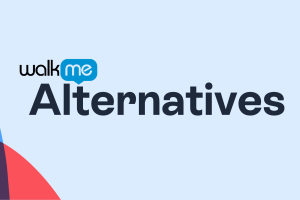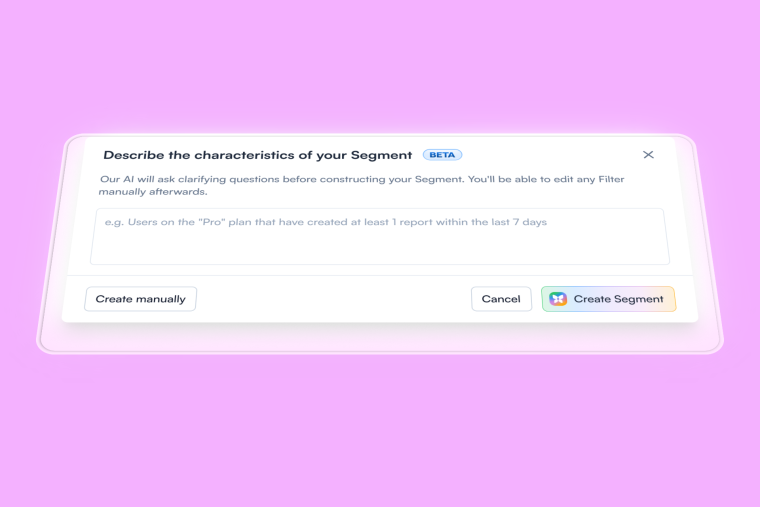Picture your SaaS product as a sandwich. Digital Adoption Platforms (DAPs) are the dressing that transforms it from a dry, chewy bite into a burst of flavor that excites you for more. But what exactly is a Digital Adoption Platform?
A Digital Adoption Platform is a tool that overlays your software applications, providing users with in-context guidance and personalized experiences to help them use the product effectively. These platforms use artificial intelligence and machine learning to offer features such as interactive walkthroughs, step-by-step overlays, self-help menus, and contextual information. This helps product teams onboard new users, introduce new features, and promote self-serve learning.
DAPs are designed to accelerate user proficiency by directing users through key tasks and providing real-time support. They reduce onboarding time, lower the burden on IT support, and increase user satisfaction and morale. Additionally, DAPs provide valuable insights into user behavior and engagement, allowing organizations to refine their digital adoption strategies and ensure users get the most out of the software.
By using DAPs, organizations can drive faster user adoption, accelerate employee training, and enhance overall technology adoption across the organization.
This article will walk you through the what, the why, and the how of digital adoption and give you a look into the best-in-class DAPs to consider. We’ll also share our tried and tested selection process with you to ensure you find a perfect platform for your business needs.
Lunch is served.
Best digital adoption platforms compared
Tool name | Features | Pricing | Average G2 rating |
Chameleon | Product Tours, Modals, Banners, Embedded Cards, Tooltips, Checklists, and more | Starts at $279/month for Startups; Growth & Enterprise plans at $1,250/month | |
Appcues | In-app onboarding tours, feature announcements, product usage data analysis | Essentials plan at $299/month; Growth plan at $879/month | 4.6 / 5 |
ChurnZero | Real-time customer success platform, integrates with CRM | Custom quote required | 4.7 / 5 |
Intercom | In and off-app messaging, automation, Live Chat, Support Bots | Starts at $74/month | 4.5 / 5 |
Pendo | In-app messages, feature guides, product walkthroughs, customer feedback | Free for up to 1,000 MAUs | 4.4 / 5 |
Userflow | Product tours, onboarding checklists, resource centers, surveys | Starts at $250/month | 4.8 / 5 |
UderGuiding | Interactive product walkthroughs, goal tracking, analytics | Starts at $69/month after 1-month free trial | 4.6 / 5 |
Userpilot | Behavior-driven in-product experiences, surveys | Growth plan at $299/month; Enterprise at $749/month, paid annually | 4.6 / 5 |
WalkMe | Customized product Walk-Thru experiences, UI Intelligence for Microsoft Dynamics 365 | Custom quote required | 4.5 / 5 |
Whatfix | In-app guidance, on-demand support, digital transformation support | Custom quote required | 4.6 / 5 |
Stonly | Guides, checklists, UI triggers for customer service | Custom quote required | 4.8 / 5 |
Lemon Learning | In-app tutorials, integrations | Custom quote required | 4.8 / 5 |
CommandBar | AI-enhanced User Assistance, Copilot chat, Spotlight search | Starts at $249/month | 4.9 / 5 |
What are digital adoption platforms?
Digital adoption platforms (also known as a product adoption platform) are a software layer over another technology tool that guides users through. When a user adopts a SaaS tool into their tech stack, it’s safe to say that they find it useful, valuable, and feasible.
Digital adoption means a user has not only reached and rocketed past their “aha!” moment with your SaaS technology, but they’re also completely comfortable with your product and are more than likely to recommend it to a colleague or a friend.
Digital adoption can apply to your product overall, but also to specific features; as software continues to develop it’s important to help users continue to adopt and benefit from changes and new functionality.
What is the role of a digital adoption platform?
Digital adoption solutions are typically used by SaaS brands looking to decrease churn, delight users, and minimize customer effort scores for certain tasks. A solid digital adoption process should be a seamless experience between your product and the tool you’re laying over it to guide your users.
Here’s what a typical DAP implementation process looks like for SaaS businesses:
Identify user challenges: this could involve noting which tasks generate the most support tickets, observing where users typically abandon a task out of frustration or registering those rage clicks!
Analyze user behaviors: this is a more quantitative analysis, like measuring how long certain tasks take, identifying which features are underutilized, and tracking the flow (or lack of it) of user interactions within your software. The aim is to pinpoint inefficiencies and areas for improvement that might not be immediately obvious from user qualitative feedback alone.
Analyze engagement quality: don't just count logins or clicks. Instead, use surveys, interviews, and maybe even session recordings to get a fuller picture of how users feel and interact with your software. What frustrates them? What do they wish was easier? This qualitative data will tell you exactly what your DAP content needs to address first.
Start creating DAP solutions: create tailored DAP content that tackles these issues head-on. If users are skipping a valuable feature because it's too complicated, introduce a guide that breaks it down into simpler steps. Ensure each piece of content is a direct response to a specific user woe.
Continuously refine your DAP strategy: monitor how users interact with your DAP and adjust based on what you see. If certain guides are being skipped, find out why and fix them. If a particular tutorial is popular, consider why it works and apply those lessons elsewhere.
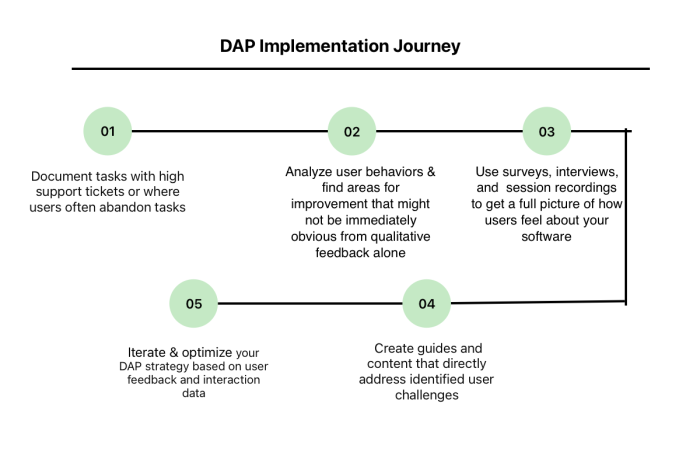
Done well, the right DAP can drastically increase user activation, retention, and your SaaS MRR.
As Gartner estimates:
“By 2025, 70% of organizations will use digital adoption solutions across the entire technology stack to overcome still insufficient application user experiences.”
Now, let’s take a look into some of the best digital adoption platform examples.
13 Top digital adoption platforms (DAPs) for user onboarding & feature adoption
Now that you know what DAPs are, let’s look into which digital adoption tools are among the best and how to choose the right fit for your business needs.
1. Chameleon
G2 rating: 4.5 / 5
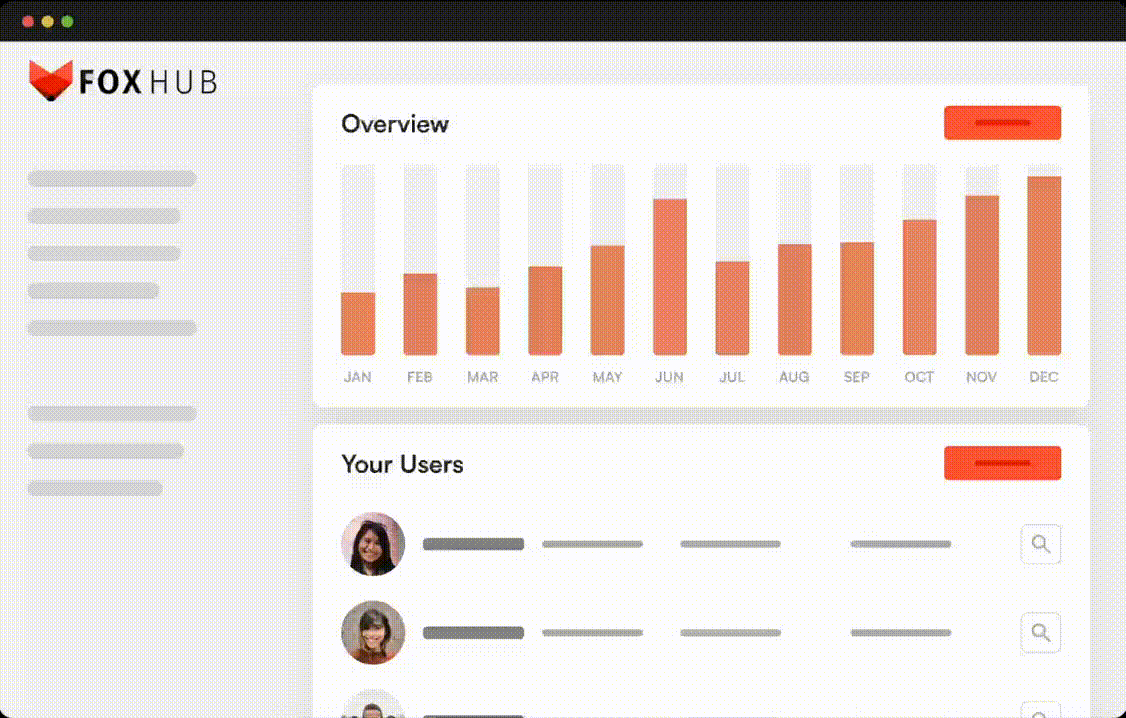 Elevator pitch: Chameleon is a best-in-class Digital Adoption Platform that empowers product teams to create personalized, in-context experiences like Tours, Microsurveys, Tooltips, and Launchers without heavy reliance on engineering teams. As a lightweight, modern, and focused offering, Chameleon prioritizes ease of use and deep integration, providing advanced features such as:
Elevator pitch: Chameleon is a best-in-class Digital Adoption Platform that empowers product teams to create personalized, in-context experiences like Tours, Microsurveys, Tooltips, and Launchers without heavy reliance on engineering teams. As a lightweight, modern, and focused offering, Chameleon prioritizes ease of use and deep integration, providing advanced features such as:
Real-time event-based targeting to deliver messages at the right moment.
Custom CSS for advanced customization.
Rate-limiting to manage message frequency.
A/B testing to optimize product flows.
Native integrations with analytics tools, CRMs, and other technologies.
User segmentation and onboarding guides to deliver targeted experiences.
Interactive demos and walkthroughs to improve user onboarding and feature adoption by recording app navigation, editing captures, and embedding them on various platforms
Key Features of Chameleon
No-Code Builder
Chameleon features an intuitive no-code builder that allows product teams to create in-app experiences without any coding. This enables rapid deployment and simplifies the process of building and managing product tours and other in-product experiences.
Personalized User Experiences
Chameleon delivers tailored content based on user behavior and attributes. This is achieved through contextual targeting, where you can define specific user groups and create segments to show relevant in-product experiences.
Deep Integrations
Chameleon seamlessly integrates with your tech stack, including analytics tools, CRMs, and customer data platforms. This allows for easy data exchange and enhances the overall functionality of the platform.
Advanced Targeting
The platform supports real-time event-based targeting, enabling you to engage users at the right moment. You can create custom segments using various attributes, actions, and data from integrations to ensure targeted and effective user engagement.
A/B Testing and Analytics
Chameleon includes built-in A/B testing capabilities, allowing you to optimize in-app experiences by creating variations and analyzing user engagement. The platform also provides detailed performance insights through integrated analytics tools.
Alerts
Maintain the effectiveness of your in-app guidance by receiving real-time alerts when experiences are not being interacted with, allowing for prompt adjustments and improvements.
HelpBar
Provide users with quick access to information through a universal search feature, enabling them to find answers and resources efficiently within your application.
User Onboarding Checklists
Guide new users through tasks with onboarding checklists, helping them navigate your product effectively and achieve their goals.
Custom Branding
Chameleon allows for custom branding to ensure that in-product experiences match your brand's look and feel. You can use custom CSS to adjust font, color, opacity, and other attributes, ensuring a seamless integration with your brand's design.
Interactive Demos
You can showcase your product's capabilities with interactive demos, allowing users to explore features in a hands-on manner. You can also embed them on your website, help center, or blog articles to improve user engagement.
“Since Chameleon is a no / low code solution, almost anyone can make changes. Prior to Chameleon, we were hard coding everything into our application and it made it time consuming to make even minor changes. With Chameleon, once it was implemented in our environments it's incredibly easy to have any layperson go in and make updates whenever they need. Right now we're using it for product announcements, Microsurveys for market and product research, product walkthroughs, messaging for upselling and payment reminders, with plans across the organization to use it for much more.”
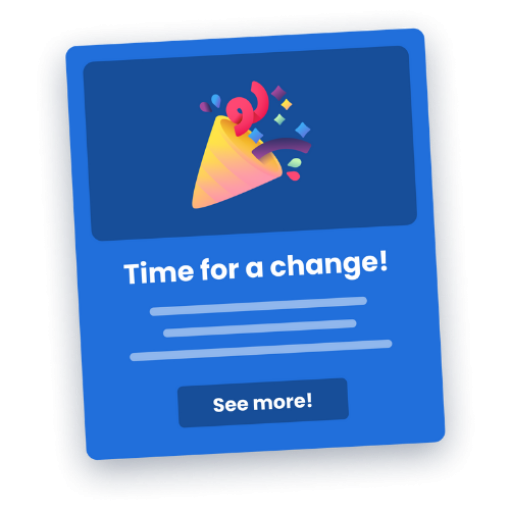
Boost product adoption with in-app messaging
Get started free with Chameleon and harness the power of product tours, tooltips, checklists, and surveys.
2. Appcues
G2 rating: 4.6 / 5
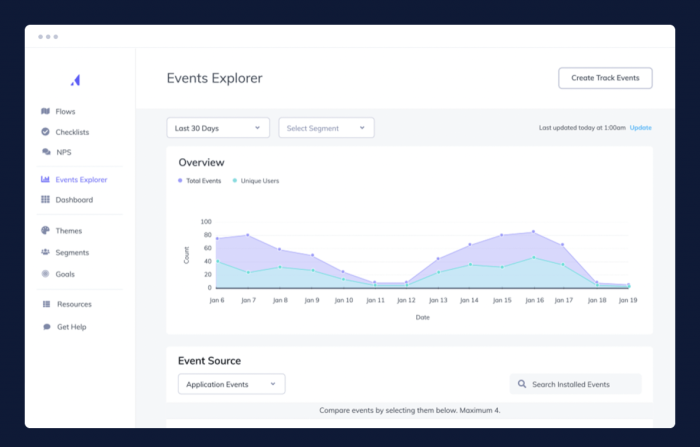
(Source)
Elevator pitch: Appcues helps non-technical teams create in-app onboarding tours, feature announcements, and in-product surveys. To better understand your user behavior, you can also use the platform to track events and analyze product usage data through reports.
Best for: Product-led SaaS businesses and larger companies with multiple products that want to improve user onboarding and manage flows within the app.
Ease of implementation: It’s easy to get started and integrate with third-party tools to scale the usage up, but note that some of the integrations would need an intermediary tool like Zapier to bridge the data flows from Appcues to other tools, and vice versa.
Pricing: The Essentials plan starts at $299 per month, the Growth plan starts at $879 per month (paid annually), and the Enterprise plan offers flexible terms, and you’ll get a custom quote for it. Pricing for each plan scales with the number of your monthly active users (MAUs).
3. ChurnZero
G2 rating: 4.7 / 5
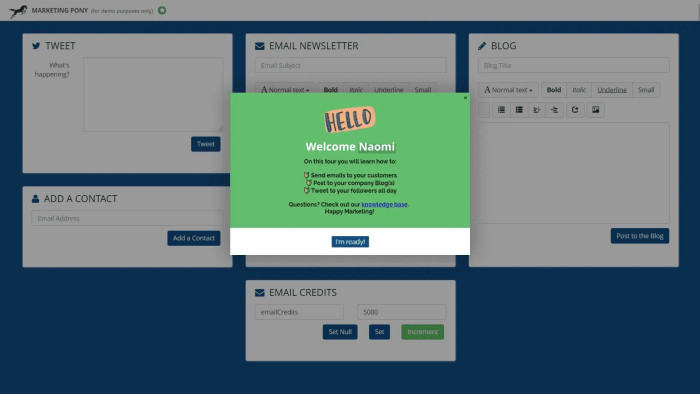
Elevator pitch: ChurnZero is a real-time customer success platform that helps subscription businesses fight churn by understanding how customers use their product and assessing their health. The tool is designed intelligently integrate the customer’s application and CRM system, giving them the means to automate and personalize customer experience based on account information and product usage.
Best for: Fast-growing subscription-based businesses looking to fight or avoid churn by continuously assessing customer health and improving customer experience by communicating directly with users in relevant touchpoints.
Ease of implementation: ChurnZero is not a plug-and-play solution, making the implementation process more complicated than alternatives. Their Ease of Setup score on G2 is 7.7/10, amongst the lowest in the category. However, their high quality of support score indicates that their Customer Success will be available to help you throughout the process.
Pricing: The company doesn’t disclose pricing information on its website unless you book a demo, but customer reviews on G2 suggest that ChurnZero has reasonable and affordable pricing for small companies.
“ Also, the price point is fantastic. ChurnZero is a tool that smaller Success organizations could use with a higher likelihood to see the return on investment sooner than larger competitors.”
- Jessica L., ChurnZero customer on G2
4. Intercom
G2 rating: 4.5 / 5
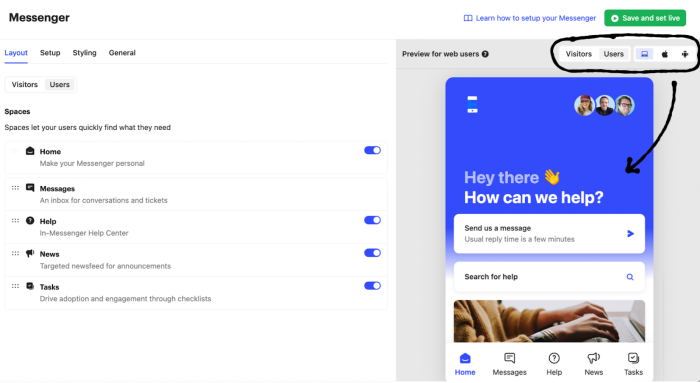
(Source)
Elevator pitch: Intercom is a digital adoption solution that connects businesses to customers using in and off-app messaging and automation technology. With Intercom, you can deliver direct support to users via their Live Chat or Messenger features, and set up Support Bots that automate the process. They also offer a Product Tour solution to create onboarding flows or product walkthroughs.
Best for: Expanding SaaS businesses that want to create an in-app channel for customer support and communicate with users in real time, thus reducing customer frustration and avoiding churn. Based on client reviews on G2, Intercom may not be the best option for more mature businesses that need deeper customization of in-app UX flows and the ability to iterate quickly.
Ease of implementation: Intercom can be installed in a few different ways depending on the type of application or software it’s being layered over, or what types of users are being targeted. Their Help Center offers guidance on all installation methods, like adding the JavaScript code snippet, running Google Tag Manager, or installing the software or a WordPress site.
Pricing: Intercom offers 3 different plans - Support, Engage, and Convert - each offering a different bundle of services depending on the customer's use case and specific needs. Pricing starts at $74/month in the Starter plan for very small businesses and is calculated based on product usage.
5. Pendo
G2 rating: 4.4 / 5
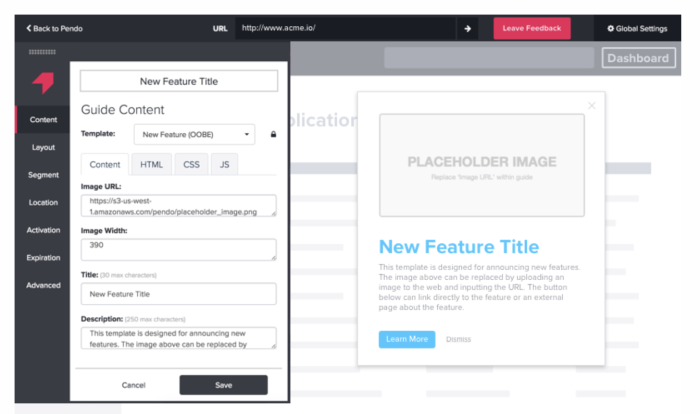
(Source)
Elevator pitch: Pendo is a product adoption tool that enables product teams to manage the overall product experience for their users, as well as to increase the adoption of employee-facing software. You can use it to create in-app messages, feature guides, and product walkthroughs based on the insights you gain from customer feedback and interactions.
Best for: SaaS products that want to increase the adoption rate for advanced features they offer to their users and companies that want to guide their employees through onboarding and change management.
Ease of implementation: The initial setup might require some training on the platform, but once you set everything up, the ease of use increases. Based on the user ratings on G2, Pendo scores 7.9/10 for ease of setup and 8.3/10 for ease of use.
Pricing: There is a Free plan for up to 1,000 MAUs, limited to one web app key and one mobile app key.. Subscription-based plans include the Team, Pro, and Enterprise plans – you’ll need to get in touch with the team to get a quote for these.
6. Userflow
G2 rating: 4.8 / 5
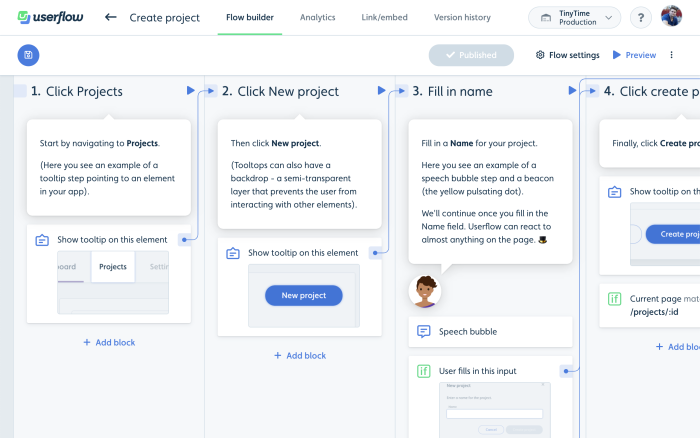
Elevator pitch: Userflow is a user onboarding software for building product tours, onboarding checklists, resource centers, and surveys with no code. Their Flow Builder allows customers to create and personalize UX flows like welcome modals, tooltips for in-app guidance, onboarding checklists, and more.
Best for: Product-led teams focused on creating user-centric experiences with control over how users journey through the product and find value at different touch points.
Ease of implementation: Userflow is a top scorer in terms of ease of use and ease of setup, scoring 9.3/10 on both categories G2. Installation using the Userflow.js code snippet is easy and their JavaScript has one of the smallest footprints in the category.
Pricing: Many G2 reviewers rate Userflow as having one of the best prices out there for a DAP. Startup plans begin at $250/month and even offer a discount if billed annually, which would bring the price down to $200.
7. UserGuiding
G2 rating: 4.6 / 5
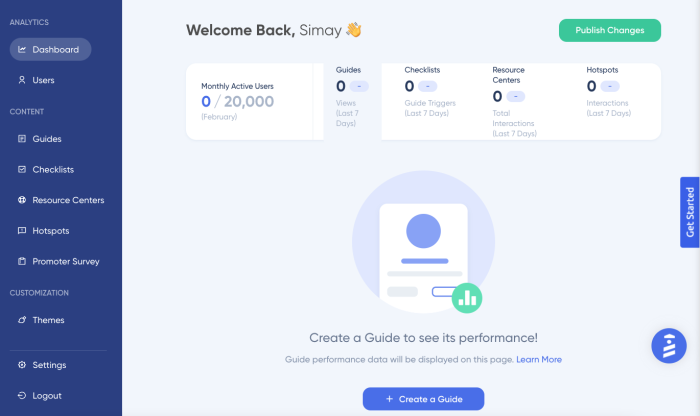
(Source)
Elevator pitch: UserGuiding allows customers to create interactive product walkthroughs and guide users to support articles. Besides the ability to create in-app flows that allow you to communicate with users directly from inside the product, UserGuiding offers features like hotspots, goal tracking, analytics, and more.
Best for: Small to mid-market SaaS companies looking for an effective in-app messaging solution that can fit their pocket and provide quick and effective customer support. UserGuiding is a top-scorer on quality of support and is often commended by customers for its excellent service.
Ease of implementation: UserGuiding is relatively easy to set up, scoring 8.9/10 on G2 for the category, a reviewer added that the software was “up and running within 10 minutes”.
Pricing: After the generous 1-month free trial, UserGuiding begins pricing at $69/month for its Basic Plan which covers up to 2500 monthly users.
8. Userpilot
G2 rating: 4.6 / 5
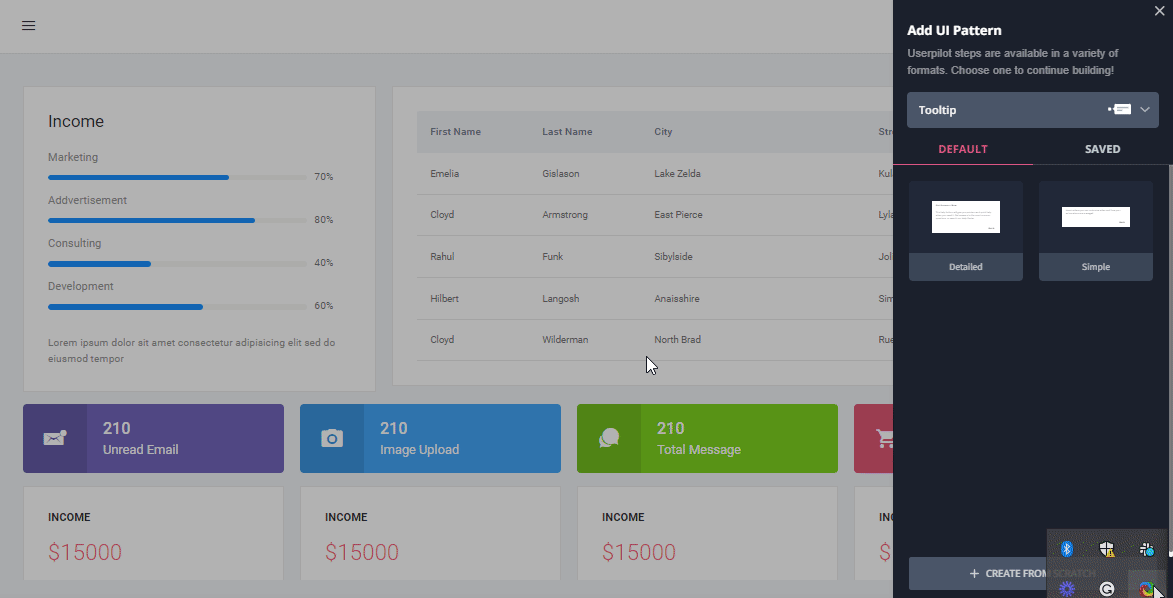
(Source)
Elevator pitch: Userpilot helps product teams create behavior-driven in-product experiences to improve the onboarding flow for new users, offer interactive tips, and guide users to their “aha!” moments. With Userpilot, you can also track and analyze your product growth and gather qualitative customer feedback through surveys.
Best for: Fast-growing SaaS businesses that want to onboard new signups with ease, offer personalized in-app messages, and stimulate feature discovery as their product evolves. Based on the user reviews on G2, it might not be the best fit for companies that are looking for advanced product analytics features or sophisticated customization options.
Ease of implementation: Userpilot’s tool is easy to implement, which got this digital adoption platform a score of 9/10 on G2 for ease of use. Besides that, its customer support is also highly rated by users, with a score of 9.9/10.
Pricing: After a free trial, the Growth plan starts at $299 per month while the Enterprise plan, which offers priority troubleshooting, advanced security options, and more, starts at $749 per month, paid annually.
9. WalkMe
G2 rating: 4.5 / 5
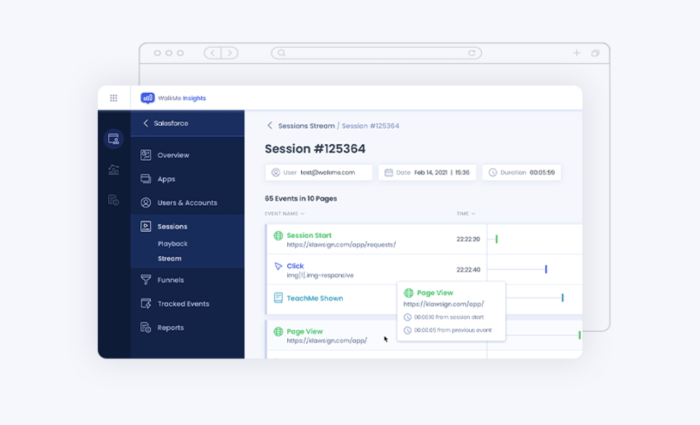
(Source)
Elevator pitch: WalkMe enables organizations to enhance the experience and improve efficiency for both employees and customers. It offers a code-free platform to measure, drive, and act to ultimately accelerate digital transformations and better realize the value of their software investments. With WalkMe, you can create customized product Walk-Thru experiences and use third-party integrations for more options. For example, one of the additional solutions that WalkMe offers is the UI Intelligence for Microsoft Dynamics 365 which adds an additional layer of product analytics.
Best for: Companies that want to increase the productivity of their teams by implementing a DAP for employee onboarding and in-app training, as well as businesses that want to improve customer satisfaction rates, and drive software adoption. Some of the industries and verticals that would be a good fit include telecommunications, retail and eCommerce, healthcare, and the public sector.
Ease of implementation: The learning curve may vary depending on your use case. The tools are easy to implement for basic usage, but the more integrations and tools you add, the more skills you’ll need for running the process of adoption effectively.
Pricing: With the Basic plan, you’ll get up to three Walk-Thrus with five steps per each, while you can customize the offer to fit your needs with the Custom plan. For each, you’ll need to reach out to their team to get a quote. Additional tools, like UI Intelligence, for example, are paid for separately.
10. Whatfix
G2 rating: 4.6 / 5
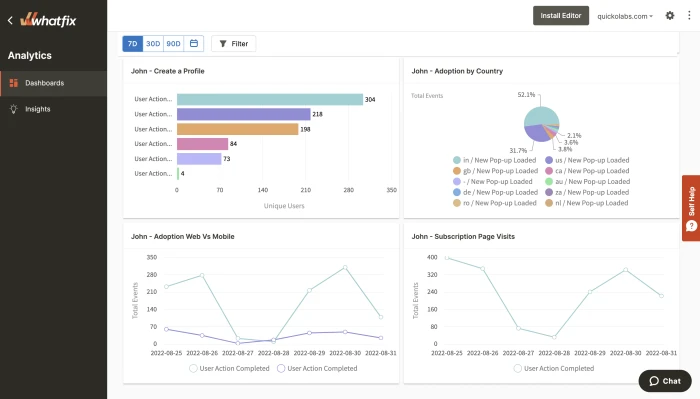
(Source)
Elevator pitch: Whatfix is a digital adoption platform aimed at in-app guidance and on-demand support, as well as driving digital transformation projects for their business processes. Their products fall under three categories: to analyze, build, and deliver in-product experiences.
Best for: Enterprise SaaS companies that need an effective way to communicate internally with employees, vendors, and other stakeholders with remote training of systems and applications and targeted change management communication.
Ease of implementation: WhatFix offers an Editor plugin for Chrome that makes it easy to get users into the product Dashboard. The product scores just below the average for digital adoption platforms in terms of ease of setup, garnering an 8.4 on G2 for the category, while the average stands at 8.6.
Pricing: Whatfix doesn’t disclose pricing information on their website or elsewhere, so you’ll have to get a quote for the full picture. One reviewer on G2 does comment that the pricing is competitive “compared to others in the market.”
11. Stonly
G2 rating: 4.8 / 5
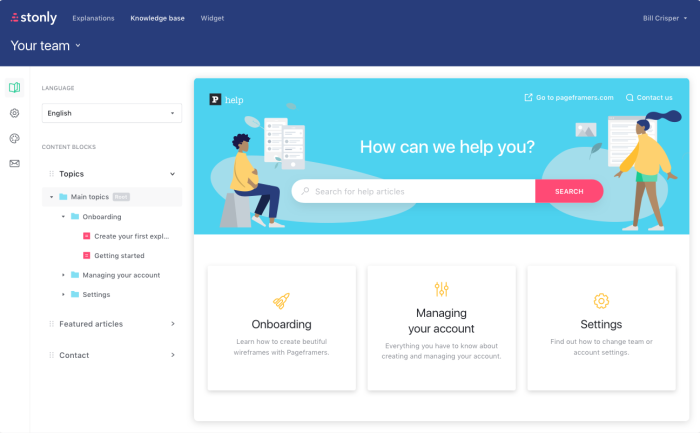
(Source)
Elevator pitch: Stonly is primarily a customer service tool that can be used to build knowledge bases. In other words, Stonly is not an actual onboarding or adoption platform but it offers features like guides, checklists and UI triggers that help increase feature adoption.
Best for: Medium-sized businesses that prioritize customer service and want to improve self-service onboarding experience with knowledge bases. It caters to both external customers and internal teams, simplifying support processes for all.
Ease of implementation: Some users praise Stonly for its easy setup and usefulness for all stakeholders, highlighting its ability to integrate with popular tools like Zendesk and Salesforce. However, others point out limitations, particularly in content segmentation, which can require creative workarounds.
Pricing: While Stonly offers plans for small businesses and enterprises, they don’t publicly share pricing details, so you'll need to reach out directly for a complete overview of their plans.
12. Lemon Learning
G2 rating: 4.8 / 5
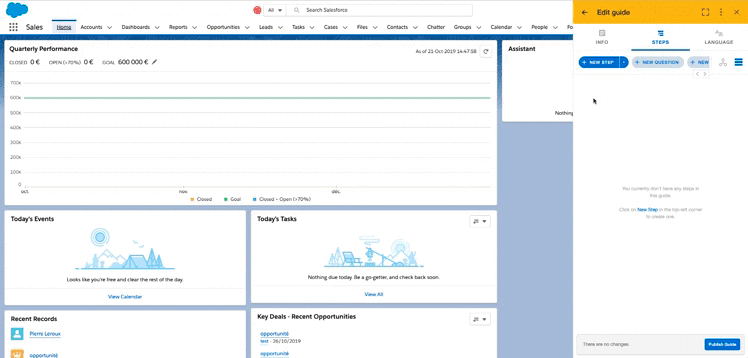
Elevator pitch: Lemon Learning offers real-time, in-app tutorials that simplify complex processes. The platform improves the onboarding experience for new users and supports ongoing training for employees so they’re up-to-date with their digital tools. This digital adoption software also integrates with popular platforms like Salesforce and Oracle.
Best for: SMBs, global enterprises, non-profit organizations that want to increase the adoption rate with minimal overhead training.
Ease of implementation: Some users report that Lemon Learning makes their workflows and processes more manageable. They find the platform user-friendly and value the support team's assistance to overcome any setup hurdles. But
Pricing: Lemon Learning doesn’t disclose pricing information on its website unless you book a demo. You'll need to reach out directly to their team for a custom quote.
13. CommandBar
G2 rating: 4.9 / 5
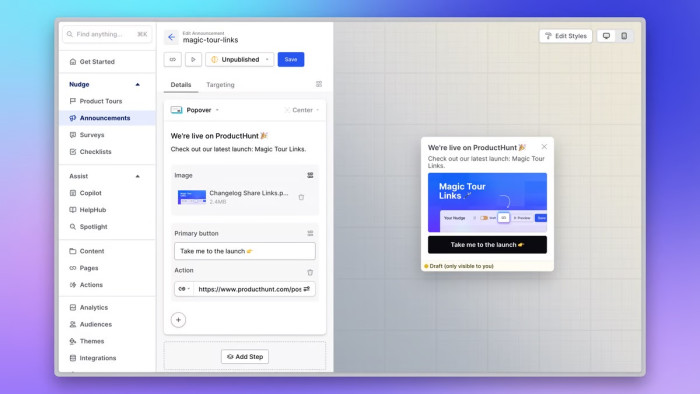
(Source)
Elevator pitch: CommandBar is an AI-enhanced User Assistance Platform. Unlike traditional pop-up guides, CommandBar offers solutions like natural language Copilot chat, Spotlight search, and smart nudges tailored to user behaviors.
Best for: Small to mid-sized tech companies that prioritize improving their user experience without a high investment in custom development.
Ease of implementation: CommandBar is relatively easy to set up, but some users have highlighted CommandBar's admin and analytics interface as a bit tricky to navigate, and expressed a desire for detailed filtering options. The CommandBar team is responsive to feedback and has made several improvements to their features based on similar suggestions.
Pricing: CommandBar offer a Starter plan at $249 per month for small teams. But if you have more than 5,000 Monthly Active Users you can opt for the Growth or Enterprise plans. These higher-tier plans are customizable, so you'll need to get in touch with CommandBar to get a quote
What are the benefits of using a DAP?
To answer this question, we reached out to our very own Pulkit Agrawal, Co-Founder, and CEO at Chameleon. His answer might surprise you:
“One of the biggest benefits of using a digital adoption platform is speed.”
Why speed? Because, as Pulkit further explains, product growth and success depend on how quickly you're able to help customers use your product successfully, and digital adoption platforms like Chameleon can help you speed that process up.
Here are some key benefits of using a DAP:
Accelerated User Onboarding: DAPs streamline the onboarding process, helping users reach their 'aha!' moment faster through interactive and customized training.
Improved Feature Adoption: Guide users to discover and adopt new features effortlessly using in-app guidance, interactive walkthroughs, and contextual tips.
Enhanced User Experience: Provide in-context assistance, reducing friction and boosting satisfaction by enabling users to solve many issues on their own.
Reduced Support Costs: Empower users to self-serve, relieving pressure on customer success teams and minimizing training needs and support costs.
Data-Driven Insights: Gain valuable analytics to inform product decisions and drive growth by tracking user behavior, adoption rates, and software utilization.
Let’s hear Pulkit out for more insights. Spoiler alert: The benefits also include saving time and resources, and running more in-product experiments, more effectively.
What types of companies will benefit from digital adoption tools the most?
The product or company types that will find the most benefit from a digital adoption platform are those that care about their software being used effectively by users.
The way Pulkit puts it:
“If your company has a software product, or it’s enabled by a software product, whether it's for internal or external users, it's really important for them to discover the functionality and use the software effectively.
This is where a digital adoption platform comes in. That typically means it's useful for all SaaS companies and even B2C products that have web-based software, as well as companies that care about being product-driven, or that want to build a self-serve motion.”
– Pulkit Agrawal, Co-Founder, and CEO at Chameleon
In other words, as Pulkit concludes, if you want to drive success at scale, or you want your users to figure things out through a tech touch without interventions from your CS team, digital adoption platforms can be very powerful and very helpful for you.
Who benefits most?
Product-Led SaaS Companies: Organizations prioritizing efficiency and scalability through self-serve models can significantly benefit from DAPs. These platforms streamline user onboarding and feature adoption, which is crucial for product-led growth.
Product Managers and Teams: Professionals seeking to enhance user onboarding and feature adoption without extensive engineering support can use DAPs to provide in-app guidance and self-help resources. This reduces the learning curve and frustration associated with new software.
Customer Success Teams: Teams aiming to reduce support tickets by empowering users with in-app guidance can leverage DAPs. This approach has been successful in reducing support tickets and improving customer satisfaction, as seen in the case of Sentry Insurance.
Data-Driven Organizations: Companies leveraging robust tech stacks and analytics to inform product decisions can benefit from the analytics and reporting capabilities of DAPs. These insights help in optimizing digital strategies and reducing training costs.
Enterprise Businesses: Firms needing to onboard employees onto complex internal systems efficiently can use DAPs to simplify the onboarding process. This ensures that employees can start using the software efficiently right away, as exemplified by KUKA's experience.
45 Use cases of a digital adoption platform
Here are 45 use cases of digital adoption for SaaS:
Business Units | Use cases |
1. Operations and process managers |
|
2. CIOs & IT managers |
|
3. Sales and marketing teams |
|
4. Customer success teams |
|
5. Training and development professionals |
|
6. Diversity and Inclusion (D&I) teams |
|
7. HR and talent management |
|
8. Sales and marketing teams |
|
9. Product managers |
|
10. Compliance and risk management |
|
11. IT support teams |
|
12. Quality assurance and testing teams |
|
13. Customer Experience (CX) teams |
|
14. Innovation and R&D teams |
|
15. Environmental, Social, and Governance (ESG) teams |
|
Best-in-class digital adoption platforms you should consider
Now that you know what DAPs are, why you should consider adding them as an additional layer to your software, and who will benefit the most, let’s look into which platforms are among the best and how to choose the right fit for your business needs.
For a visual representation of top DAP solutions, you can check out the G2 Grid® – a map based on G2 scores of products, user reviews gathered from the G2 community, and data aggregated from online sources and social networks.
This list is based on customer reviews and scores on G2 and is presented in alphabetical order.
How to choose a digital adoption platform for your SaaS
Remember that just because someone is raving about their digital adoption platform, that doesn’t mean it’s the right fit for you. You need to consider a few things when picking the perfect digital adoption process and tool for your SaaS company.
What to pay attention to the most? Let’s take a look at what Pulkit Agrawal, Co-Founder, and CEO at Chameleon, has to say.
In a nutshell, the secret lies in building and nurturing a strong relationship with the DAP solution of your choice. Think of it as a long-term partnership and you’ll be on your path to success.
Apart from that, here are some other aspects to take into consideration when making a decision.
Your access to resources
Consider what resources you have access to. Certain digital adoption platform software will require a greater lift than others, especially when it comes to human resources.
For example, do you have access to in-house developers? If not, a no-code or low-code solution may be a better fit than a solution that requires developer input.
Your product learning curve
This is an exceptionally important point to consider when picking the right DAP, or whether you need one at all. No matter how great your UX is, if your product is complicated or has multiple features, there’s a high chance your users are going to need some guidance getting started.
What does your product onboarding look like, and where are you delivering it? If it’s only in emails at the moment, then a DAP solution can offer self-serve, in-app product onboarding to help break down the complexity of your product.
“Chameleon has many features and functions out-of-the-box that our previous tools didn't offer. As a result, I have been able to quickly implement and launch feedback surveys in the tool.
Our CSM and engineering partner were extremely helpful and available to help with our questions. Everything felt smooth and we never felt left alone to figure things out! I really appreciate how easily changes can be made, and as an admin, it's clear to see what impact that change might make (without fear of pulling the trigger!).”
Your product branding and maturity
The digital adoption platforms we’ve listed above come with an array of different branding capabilities. Some fully allow you to take over and give users a seamless brand experience. However, others are quite clearly a separate product or charge more in their plans if you want to brand the overlay.
How mature is your brand, and how important is product branding right now? For example, if you’re in beta testing, branding may perhaps not be top of your list when you’re just trying to find product-market fit and build a user base.
Your digital adoption goals
Lastly, what are your goals with a DAP? What are you hoping to achieve? A few goals, KPIs, and retention metrics to consider are:
Product adoption rate
Feature adoption rate
Churn rate
Engagement rate
Customer retention rate
Customer lifetime value (CLTV)
Customer satisfaction (CSAT) score
Customer Effort Score (CES)
Net Promoter Score (NPS)
When you understand what the above metrics look like for your product, you can set some goals and KPIs around improving them with a digital adoption platform.
Best practices for implementing your digital adoption platform
Get stakeholder buy-in: Start by getting key stakeholders involved from the beginning. This ensures that the DAP aligns with your larger business goals, and helps manage resistance to change.
Focus on data integrity and migration: Prioritize organizing and cleaning your data before migration to ensure its integrity in the new system. Have a well-thought-out data migration strategy, including mapping, testing, and validation.
Implement change management for user transition: This plan should address the human elements of DAP implementation. This includes creating support structures, internal training programs, and mechanisms to manage resistance so users are prepared and supported throughout the change.
Tailor training programs and sustain internal user support: Implement training programs customized to the specific needs of various user groups—onboarding for new employees, advanced modules for technical staff, and role-specific guides for sales teams. Provide ongoing support after the DAP goes live through help desks and user guides so users have the resources they need.
Ensure DAP compliance with data privacy standards: Select a DAP that prioritizes data privacy and security, especially one that adheres to a zero-knowledge policy to ensure GDPR compliance.
No developers? No problem!
Empower your product team with Chameleon's powerful no-code builder to create product tours, tooltips, onboarding checklists, and in-app surveys.
Choose a powerful and intuitive product adoption platform
That's a wrap (or, in this case – a sandwich) of digital adoption solutions. Hopefully, you’ve discovered the best practices around digital adoption platforms you can implement for your users, product, and business.
Remember, choosing the right DAP is about finding a solution that aligns with your goals and provides ease of use and deep integration without heavy reliance on engineering teams. A powerful DAP should offer no-code solutions, intuitive interfaces, and seamless integration with various applications. It should also provide robust analytics and reporting to help you track user behavior and optimize your digital strategies.
Key Features to Consider
Ease of Use: Look for a DAP that offers in-context help through walkthroughs, tips, notifications, and searchable articles. This ensures that users can access support exactly when they need it, improving their overall experience and productivity.
Deep Integration: Ensure the platform integrates seamlessly with your existing software ecosystem, providing support without users having to switch contexts or leave the application.
Analytics and Reporting: A good DAP should offer robust analytics capabilities to track user behavior and provide insights into how digital tools are being used.
Benefits of the Right DAP
Improved User Adoption: The right DAP can significantly increase end-user adoption rates, as seen in cases where organizations have achieved up to a 50% increase in user adoption within a short period.
Cost Savings: Organizations using DAPs can experience substantial cost savings, including a 75% reduction in training costs and a 50% decrease in support tickets.
Enhanced Productivity: By providing real-time guidance and support, DAPs help users quickly learn new technology, reducing training time and increasing overall productivity.
Best Practices for Selection
Align with Business Goals: Ensure the DAP is part of a comprehensive digital adoption strategy that aligns with your business goals. Engage stakeholders early and get buy-in from leadership and end-users.
Customization and Scalability: Choose a platform that offers flexibility to accommodate new software integrations and evolving user requirements. Customize onboarding processes and support resources to address specific user needs.
Predictive Analytics and AI Integration: Consider advanced DAPs that incorporate AI and predictive analytics to provide more intelligent and personalized guidance.
In closing, try to track and analyze product usage to kick-start your company's digital adoption process on the right foot. Once you’ve got a better understanding of your users and data, you can compare the above products to find what’s the best fit for you. Remember, all of them are designed to help SaaS applications succeed, but that doesn’t mean they’ll be perfect for your needs. Take your time in working through your selection process.
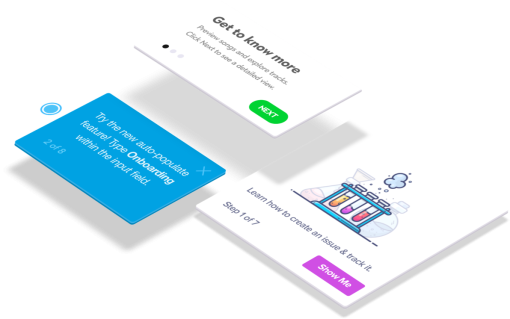
Build in-app guides to retain users
Chameleon makes it easy for product teams to create product tours, tooltips, onboarding checklists, and in-app surveys without code.
Frequently asked questions on digital adoption platforms
-
There are three main types of product adoption: 1. End-user adoption focuses on understanding how direct users learn, use, and integrate the product into their routines 2. Departmental adoption emphasizes how a product is used to optimize, improve, or transform specific departmental processes and workflows 3. Organizational adoption involves strategic alignment of the product with business goals and requires buy-in from all levels: from top management to end-users
-
A digital adoption tool simplifies how employees and customers use new software by offering interactive tutorials, personalized help based on the user's role, and instant answers to common questions right inside the application. It also analyzes where users often get stuck, allowing for continuous improvement of the guidance provided.
-
Some of the top digital adoption platforms examples include Chameleon, Appcues, ChurnZero, Intercom and Pendo. Although, there are a lot more out there. When picking a digital adoption platform, make sure it lines up with your needs, budget, and growth plans.


